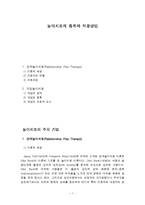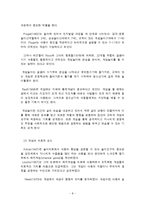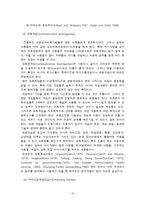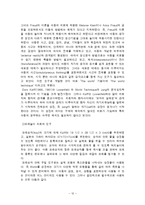1) 이론적 배경
2) 치료자의 역할
3) 치료과정
2. 게임놀이치료
1) 게임의 정의
2) 게임의 종류
3) 게임의 치료적 요소
1. 관계놀이치료(Relationship Play Therapy)
1) 이론적 배경
Jesse Taft(1933)와 Frederick Allen(1934)에 의하여 소개된 관계놀이치료 이론은 Otto Rank의 이론에 기초를 둔 놀이치료 이론이다. Otto Rank(1936)는 아동의 발달단계중 출생의 심리적 상처(birth trauma)를 중요한 요인으로 강조한 사람이다. Otto Rank에 의하면 사람들은 이 출생의 심리적 상처 때문에 분리-분화(individuatation)가 되는 것에 대해 두려움을 느끼게 되며 분화의 어려움 때문에 갈등을 겪게 된다고 한다. 그러므로 심리치료에서는 내담자의 과거경험이나 무의식을 강조하기보다는 오히려 현재의 상태를 중요하게 여기며 특히 치료자와 내담자의 관계(relationship)의 발달이 중요하다고 강조한다. 따라서 관계치료에서는 치료자와 내담자의 현재 이 시점(here and now)에 치료의 촛점을 둔다.
Taft(1933), Allen(1942), Moustakas(1959)는 Otto Rank의 이론을 아동의 놀이치료에 적용시킨 대표적인 사람들이다. 이 세 학자들은 아동의 출생시의 심리적 상처가 아동이 긍정적인 인간관계를 맺는데 걸림돌이 되고 있다고 보았다. 이런 부정적인 경험때문에 아동들은 최초의 양육자와 분리-개별화의 과정에서 어려움을 겪게 되는데, 이런 과정에서 심한 어려움을 겪은 아동들은 지나치게 의존적인 아이가 되거나 심하게 매달리거나 아니면 반대로 고립된 아이가 된다. 혹은 겉으로는 인간관계를 맺고 있는 것 같아 보이지만 실제로는 깊은 인간관계를 맺지 못하는 아이가 되기도 한다.
관계놀이치료란 이런 출생의 심리적인 상처가 치료자와의 깊고 따뜻한 인간관계를 경험함으로써 변화되는 치료과정이다. 그러므로 관계놀이치료에서는 치료의 제일 중요한 요인으로 치료자와 아동간의 정서적 관계(emotional relationship)를 강조한다.
2) 치료자의 역할
관계놀이치료에서는 아동으로 하여금 과거 경험을 설명하게 하는 것이 도움이 되지 않는다고 여기며, 그 대신 아동의 현재 감정이나 행동에 초점을 둠으로써 다른 치료방법에 비해 치료기간을 단축시킬 수 있다고 본다. 그러므로 치료자는 아동의 과거 경험이 아닌 현재의 느낌이나 행동에 초점을 두는 것이다.
Allen, F. (1942). Psychotherapy with children.. New York: Norton.
Axline, V. (1947). Nondirective play therapy for poor readers. Journal of Consulting psychology, 11, 61-69.
Axline, V. (1955). Play therapy procedures and results. American Journal of Orthopsychiatry, 25, 618-626.
Burks, H. (1978). Imagine. Huntington Beach, CA: Arden.
Campell, M. B. (1968). Neurological allergy. Review of allergy, 22, 80-89.
Creative Health Services. (1983). The Self-Esteem Game. South Bend, IN:
Csikszentmihalyi, M. (1976). What the play says about behavior. Ontario Psychologist, 8, 5-11.
Gardner, R. A. (1973). The Talking, Feeling, Doing Game. Cresskill, NJ: Creative Therapeutics.
Hendricks, S. (1971). A descriptive analysis of the process of child-centered play therapy (Doctoral dissertation, North Texas State University. 1971). Dissertation Abstracts International, 32, 3689A.
Kalff, M. (1989). Sandplay. Boston:Sigo.
Loomis, E. A. (1957). The use of checkers in handling certain resistances in child therapy and child analysis. Journal of the Americans Psychoanalytical Association, 5, 130-135.
Lowenfeld, M. (1938). The theory and use of play in the psychotherapy of childhood. Journal of Mental Science, 84. 1057-1058.
Moustakas, C. (1955). Emotional adjustment and the play therapy process. Journal of Genetic Psychology, 86, 79-99.
Moustakas, C. (1959). Psychotherapy with children: The living relationship. New York: Harper and Row.
Mead, G. H. (1934). Mind, self, and society. Chicago: University of Chicago Press.
Meeks, J. (1970). Children who cheat at games. Journal of Child Psychiatry, 9, 157-174.
Piaget, J. (1962). Play, Dreams, and imitation in childhood. New York: Rutledge.
Rank, o. (1936) Truth and reality and will therapy. New Yirk: Knopf.
Redl, F. (1958). The impact of game ingredients on children's play behavior. Proceeding of the Fourth Conference on Group Processes, 4, 33-81.
Redl, F. and Wineman, D. (1951). Children who hate. New York: Free Press.
Schelling, T. C. (1960). The strategy of conflict. New York: Oxford University Press.
Sutton-Smith, B. and Roberts, J. M. (1971). The cross-cultural and psychological study of games. International Review of Sport Sociology, 6, 79-87.
Taft, J. (1933). The dynamics of therapy in a controlled relationship. New York: Macmillan.
Zigler, E. and Child, I. L. (1956). Scialization. In G. Lindzey and E. Aronson(Eds.), Handbook of social psychology. Reading, MA: Addison-Wesley.
Zakich, R. and Monore, S. (1979). Reunion. Placentia, CA: The Ungame company.




















 분야
분야


